One of the Berlin studios which photographed film stars for the postcards of Ross Verlag was Atelier Sandau. Between 1919 and 1939, Ernst Sandau portrayed many actors in his studio at Unter den Linden, but he also made fashion photos for such women magazines as >die neue linie<. During the Third Reich, he changed his subject to Ritterkreuzträger (Knight Cross Holders). For this post, we selected 20 Ross Verlag postcards for which Sandau made the photographs between 1919 and 1940.

German postcard by Ross Verlag, Berlin, no. 480/1, 1919-1924. Photo: Ernst Sandau, Berlin.
Prima ballerina, dancer, singer, and actress Liane Haid (1895-2000) was the first film star of Austria. She was the epitome of the Süßes Wiener Mädel (Sweet Viennese Girl), and from the mid-1910s on she made close to a hundred films.

German postcard by Ross Verlag, no. 510/2, 1919-1924. Photo: Ernst Sandau, Berlin.
A postcard from Pola Negri's (1897-1987) German years before she moved to Hollywood. In the late 1910s and the 1920s, she achieved notoriety as a femme fatale in silent films in Poland, Berlin, and Hollywood. Negri was an overnight sensation in Ernst Lubitsch's Madame du Barry/Passion (1919). Her vamp roles were so popular that she was a direct rival of Theda Bara, and lived in a Hollywood palace, modelled after the White House.

German postcard by Ross Verlag, Berlin. Photo: Ernst Sandau, Berlin.
Ossi Oswalda (1895-1947) was one of the most popular comediennes of the German silent cinema. Her popularity at the time earned her the nickname 'The German Mary Pickford'.

German postcard by Ross Verlag, no. 982/1, 1925-1926. Photo: Ernst Sandau, Berlin.
Margarete Lanner (1896–1981) was a German stage and film actress. She appeared in around 30 films during the silent era in a mixture of leading and supporting roles. She had a small part in Fritz Lang's classic Metropolis (1927).

German postcard by Ross Verlag, no. 1097/1, 1927-1928. Photo: Ernst Sandau, Berlin.
Margarete Schön (1895-1985) is best known for her role as Kriemhild, the beautiful but revengeful princess of Burgundy in Fritz Lang’s silent epic Die Nibelungen (1924). The career of this German stage and film actress spanned nearly fifty years.
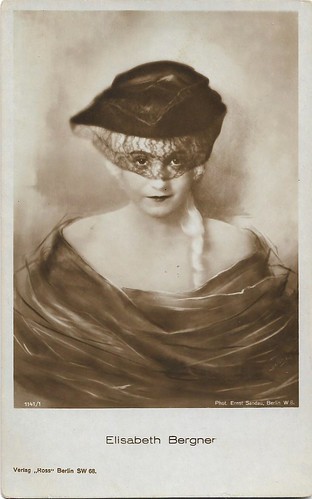
German postcard by Ross Verlag, no. 1141/1, 1927-1928. Photo: Ernst Sandau, Berlin.
The profoundly sensitive acting of Austrian-British actress Elisabeth Bergner (1897-1986) influenced the German cinema of the 1920s and 1930s. She specialised in a bisexual type that she portrayed in Der Geiger von Florenz and in other film and stage roles. Nazism forced her to go in exile, but she worked successfully in the West End and on Broadway.

German postcard by Ross Verlag, no. 1325/1, 1927-1928. Photo: Ernst Sandau, Berlin.
Austrian-born stage and film actor and theatre director Fritz Kortner (1892-1970) was one of the best-known character actors of the German silent cinema. His specialty was playing sinister and threatening roles.

German postcard by Ross Verlag, Berlin, no. 1427/1, 1927-1928. Photo: Ernst Sandau.
Alfred Abel (1879-1937) played in over 140 silent and sound films between 1913 and 1938. He is best known as the industrial Fredersen in Fritz Lang's Metropolis (1927).
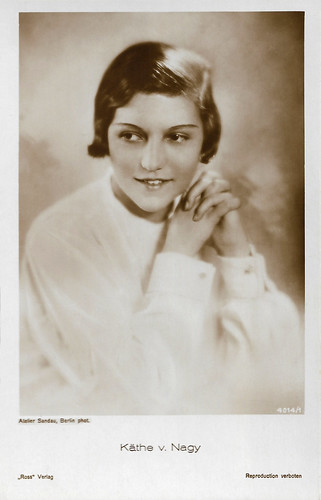
German postcard by Ross Verlag, no. 4014/1, 1929-1930. Photo: Atelier Sandau, Berlin.
Hungarian actress Käthe von Nagy (1904-1973) started as the ‘Backfish’ of German films of the late 1920s. In the early 1930s, she became a fashionable and charming star of the German and French cinema.

German postcard by Ross Verlag, no. 4015/1, 1929-1930. Photo: Atelier Sandau, Berlin. Collection: Geoffrey Donaldson Institute.
German actress Brigitte Helm (1908-1996) is still famous for her dual role as Maria and her double the evil Maria, the Maschinenmensch, in the silent SF classic Metropolis (Fritz Lang, 1927). After Metropolis she made a string of over 30 films in which she almost always had the starring role. She easily made the transition to sound films, before she abruptly retired in 1935.
Ernst Sandau was the son of another photographer named Ernst Sandau. His father was born in 1880 in Linköping in Sweden and his original name was allegedly Ernst Sigfrid Pettersson, which he changed around 1895. Sandau senior was a royal Swedish court photographer and a civil engineer.
Ernst Senior came to Berlin around 1905 and established himself there as a portrait photographer. From about 1910, he ran his studio in the house Unter den Linden 19, where Erich Sellin had worked before him. Later the Atelier Sandau was in Unter den Linden 41, in which photographer Tita Binz later also worked.
After his death in 1918, Ernst Sandau's photo studio in Berlin was taken over by photographer Suse Byk.
Ernst Junior had also become a photographer. He focused on fashion and worked for such women magazines as >die neue linie<. Like Tita Binz, Ernst Jr. also got work orders from Ross Verlag.
He started there around 1919. The last Ross Verlag postcards with his pictures date from ca. 1940. In this period, he also portrayed Ritterkreuzträger (Knight Cross Holders). Little is known further about Ernst Sandau's life.
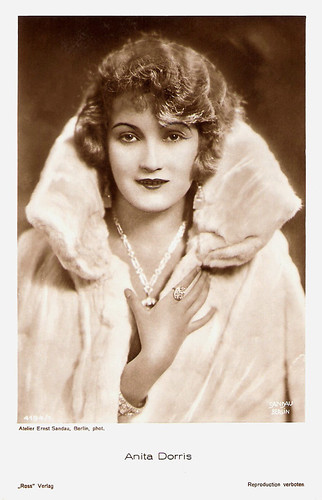
German postcard by Ross Verlag, no. 4194/1, 1929-1930. Photo: Atelier Ernst Sandau, Berlin.
Beautiful German leading lady Anita Dorris (1903-1993) started as a stage actress in 1921, after which some 15 silent films followed. Dorris was beloved in the late 1920s and smoothly made the passage to sound. In 1930, however, she married Austrian film director E. W. Emo and withdrew from the cinema. Her daughter, Maria Emo, would also become a well-known stage and film actress.
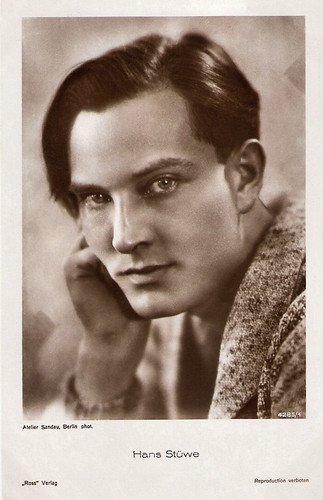
German postcard by Ross Verlag, no. 4285/1. 1929-1930. Photo: Atelier Sandau, Berlin.
Hans Stüwe (1901-1976) was a German singer and opera director. From 1926 on he was also a big film star in Germany. Four times he was the film partner of Ufa diva Zarah Leander.

German postcard by Ross Verlag, no. 6646/2, 1931-1932. Photo: Vogel-Sandau, Berlin.
Strikingly beautiful Anna Sten (1908-1993) was a Ukrainian-born actress, who became the most famous, or rather, the most notorious of the many ‘new Greta Garbos’ of the 1930s.

German postcard by Ross Verlag, no. 9289/1, 1935-1936. Photo: Atelier Sandau, Berlin.
Pretty Austrian actress Jenny Jugo (1904-2001) starred between 1931 and 1942 in eleven smart and charming comedies directed by Erich Engel.

German postcard by Ross Verlag, no. A 1623/1, 1937-1938. Photo: Sandau.
Classic beauty Anneliese Uhlig (1918-2017) was an elegant and enchanting femme fatale of Ufa crime films of the 1940s, who unwillingly bewitched Joseph Goebbels. After the war, the German actress worked also internationally as a journalist, theatre producer, and university teacher and became an American citizen.

German postcard by Ross Verlag, no. A 1772/1, 1937-1938. Photo: Sandau, Berlin. Collection: Didier Hanson.
Beautiful Lída Baarová (1914–2000) was a glamorous Czech film star who worked in Prague, Berlin, and Rome. A dangerous affair with Joseph Goebbels, the propaganda minister of the Third Reich, first enhanced and later seriously damaged her career.
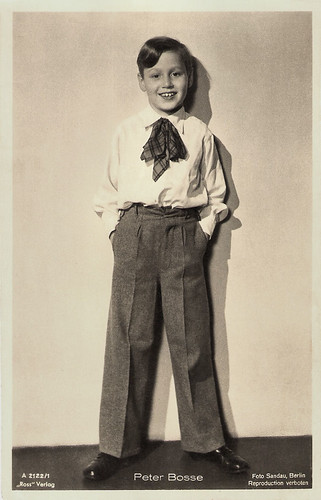
German postcard by Ross Verlag, no. A 2122/1, 1939-1940. Photo: Sandau, Berlin.
Actor, presenter, and journalist Peter Bosse (1931-2018) was a popular child star of the German cinema in the 1930s. The boy with his cheeky face made 28 films.
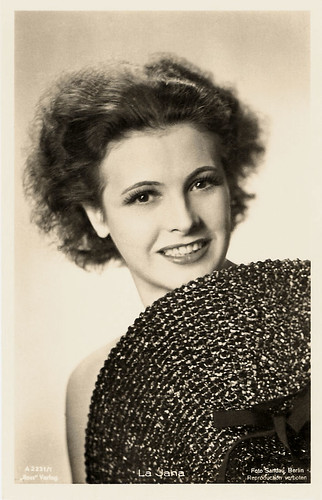
German postcard by Ross Verlag, no. A 2231/1, 1939-1940. Photo: Sandau, Berlin.
Sexy German dancer and film actress La Jana (1905-1940) was the most popular showgirl of Berlin in the 1930s. She appeared in 25 European films, often dancing in exotic costumes. In 1940, she suddenly died of pneumonia and pleurisy.

German postcard by Ross Verlag, no. A 2401/1, 1939-1940. Photo: Tobis / Sandau.
Viktor de Kowa (1904-1973) was a German actor, singer, director, and comedy writer. In the 1930s he became one of the most prominent and beloved comedy actors of the German cinema.

German postcard by Ross Verlag, no. A 2454/1, 1939-1940. Photo: Sandau / Tobis.
Austrian actress Viktoria von Ballasko (1909-1976) was a leading lady of the German cinema of the 1930s and 1940s. She also worked as a writer.
Sources: Johannes Christoph Moderegger (Modefotografie in Deutschland 1929-1955 - German), Wikipedia (German), and Pantorijn.

German postcard by Ross Verlag, Berlin, no. 480/1, 1919-1924. Photo: Ernst Sandau, Berlin.
Prima ballerina, dancer, singer, and actress Liane Haid (1895-2000) was the first film star of Austria. She was the epitome of the Süßes Wiener Mädel (Sweet Viennese Girl), and from the mid-1910s on she made close to a hundred films.

German postcard by Ross Verlag, no. 510/2, 1919-1924. Photo: Ernst Sandau, Berlin.
A postcard from Pola Negri's (1897-1987) German years before she moved to Hollywood. In the late 1910s and the 1920s, she achieved notoriety as a femme fatale in silent films in Poland, Berlin, and Hollywood. Negri was an overnight sensation in Ernst Lubitsch's Madame du Barry/Passion (1919). Her vamp roles were so popular that she was a direct rival of Theda Bara, and lived in a Hollywood palace, modelled after the White House.

German postcard by Ross Verlag, Berlin. Photo: Ernst Sandau, Berlin.
Ossi Oswalda (1895-1947) was one of the most popular comediennes of the German silent cinema. Her popularity at the time earned her the nickname 'The German Mary Pickford'.

German postcard by Ross Verlag, no. 982/1, 1925-1926. Photo: Ernst Sandau, Berlin.
Margarete Lanner (1896–1981) was a German stage and film actress. She appeared in around 30 films during the silent era in a mixture of leading and supporting roles. She had a small part in Fritz Lang's classic Metropolis (1927).

German postcard by Ross Verlag, no. 1097/1, 1927-1928. Photo: Ernst Sandau, Berlin.
Margarete Schön (1895-1985) is best known for her role as Kriemhild, the beautiful but revengeful princess of Burgundy in Fritz Lang’s silent epic Die Nibelungen (1924). The career of this German stage and film actress spanned nearly fifty years.

German postcard by Ross Verlag, no. 1141/1, 1927-1928. Photo: Ernst Sandau, Berlin.
The profoundly sensitive acting of Austrian-British actress Elisabeth Bergner (1897-1986) influenced the German cinema of the 1920s and 1930s. She specialised in a bisexual type that she portrayed in Der Geiger von Florenz and in other film and stage roles. Nazism forced her to go in exile, but she worked successfully in the West End and on Broadway.

German postcard by Ross Verlag, no. 1325/1, 1927-1928. Photo: Ernst Sandau, Berlin.
Austrian-born stage and film actor and theatre director Fritz Kortner (1892-1970) was one of the best-known character actors of the German silent cinema. His specialty was playing sinister and threatening roles.

German postcard by Ross Verlag, Berlin, no. 1427/1, 1927-1928. Photo: Ernst Sandau.
Alfred Abel (1879-1937) played in over 140 silent and sound films between 1913 and 1938. He is best known as the industrial Fredersen in Fritz Lang's Metropolis (1927).

German postcard by Ross Verlag, no. 4014/1, 1929-1930. Photo: Atelier Sandau, Berlin.
Hungarian actress Käthe von Nagy (1904-1973) started as the ‘Backfish’ of German films of the late 1920s. In the early 1930s, she became a fashionable and charming star of the German and French cinema.

German postcard by Ross Verlag, no. 4015/1, 1929-1930. Photo: Atelier Sandau, Berlin. Collection: Geoffrey Donaldson Institute.
German actress Brigitte Helm (1908-1996) is still famous for her dual role as Maria and her double the evil Maria, the Maschinenmensch, in the silent SF classic Metropolis (Fritz Lang, 1927). After Metropolis she made a string of over 30 films in which she almost always had the starring role. She easily made the transition to sound films, before she abruptly retired in 1935.
Father and Son
Ernst Sandau was the son of another photographer named Ernst Sandau. His father was born in 1880 in Linköping in Sweden and his original name was allegedly Ernst Sigfrid Pettersson, which he changed around 1895. Sandau senior was a royal Swedish court photographer and a civil engineer.
Ernst Senior came to Berlin around 1905 and established himself there as a portrait photographer. From about 1910, he ran his studio in the house Unter den Linden 19, where Erich Sellin had worked before him. Later the Atelier Sandau was in Unter den Linden 41, in which photographer Tita Binz later also worked.
After his death in 1918, Ernst Sandau's photo studio in Berlin was taken over by photographer Suse Byk.
Ernst Junior had also become a photographer. He focused on fashion and worked for such women magazines as >die neue linie<. Like Tita Binz, Ernst Jr. also got work orders from Ross Verlag.
He started there around 1919. The last Ross Verlag postcards with his pictures date from ca. 1940. In this period, he also portrayed Ritterkreuzträger (Knight Cross Holders). Little is known further about Ernst Sandau's life.

German postcard by Ross Verlag, no. 4194/1, 1929-1930. Photo: Atelier Ernst Sandau, Berlin.
Beautiful German leading lady Anita Dorris (1903-1993) started as a stage actress in 1921, after which some 15 silent films followed. Dorris was beloved in the late 1920s and smoothly made the passage to sound. In 1930, however, she married Austrian film director E. W. Emo and withdrew from the cinema. Her daughter, Maria Emo, would also become a well-known stage and film actress.

German postcard by Ross Verlag, no. 4285/1. 1929-1930. Photo: Atelier Sandau, Berlin.
Hans Stüwe (1901-1976) was a German singer and opera director. From 1926 on he was also a big film star in Germany. Four times he was the film partner of Ufa diva Zarah Leander.

German postcard by Ross Verlag, no. 6646/2, 1931-1932. Photo: Vogel-Sandau, Berlin.
Strikingly beautiful Anna Sten (1908-1993) was a Ukrainian-born actress, who became the most famous, or rather, the most notorious of the many ‘new Greta Garbos’ of the 1930s.

German postcard by Ross Verlag, no. 9289/1, 1935-1936. Photo: Atelier Sandau, Berlin.
Pretty Austrian actress Jenny Jugo (1904-2001) starred between 1931 and 1942 in eleven smart and charming comedies directed by Erich Engel.

German postcard by Ross Verlag, no. A 1623/1, 1937-1938. Photo: Sandau.
Classic beauty Anneliese Uhlig (1918-2017) was an elegant and enchanting femme fatale of Ufa crime films of the 1940s, who unwillingly bewitched Joseph Goebbels. After the war, the German actress worked also internationally as a journalist, theatre producer, and university teacher and became an American citizen.

German postcard by Ross Verlag, no. A 1772/1, 1937-1938. Photo: Sandau, Berlin. Collection: Didier Hanson.
Beautiful Lída Baarová (1914–2000) was a glamorous Czech film star who worked in Prague, Berlin, and Rome. A dangerous affair with Joseph Goebbels, the propaganda minister of the Third Reich, first enhanced and later seriously damaged her career.

German postcard by Ross Verlag, no. A 2122/1, 1939-1940. Photo: Sandau, Berlin.
Actor, presenter, and journalist Peter Bosse (1931-2018) was a popular child star of the German cinema in the 1930s. The boy with his cheeky face made 28 films.

German postcard by Ross Verlag, no. A 2231/1, 1939-1940. Photo: Sandau, Berlin.
Sexy German dancer and film actress La Jana (1905-1940) was the most popular showgirl of Berlin in the 1930s. She appeared in 25 European films, often dancing in exotic costumes. In 1940, she suddenly died of pneumonia and pleurisy.

German postcard by Ross Verlag, no. A 2401/1, 1939-1940. Photo: Tobis / Sandau.
Viktor de Kowa (1904-1973) was a German actor, singer, director, and comedy writer. In the 1930s he became one of the most prominent and beloved comedy actors of the German cinema.

German postcard by Ross Verlag, no. A 2454/1, 1939-1940. Photo: Sandau / Tobis.
Austrian actress Viktoria von Ballasko (1909-1976) was a leading lady of the German cinema of the 1930s and 1940s. She also worked as a writer.
Sources: Johannes Christoph Moderegger (Modefotografie in Deutschland 1929-1955 - German), Wikipedia (German), and Pantorijn.
No comments:
Post a Comment